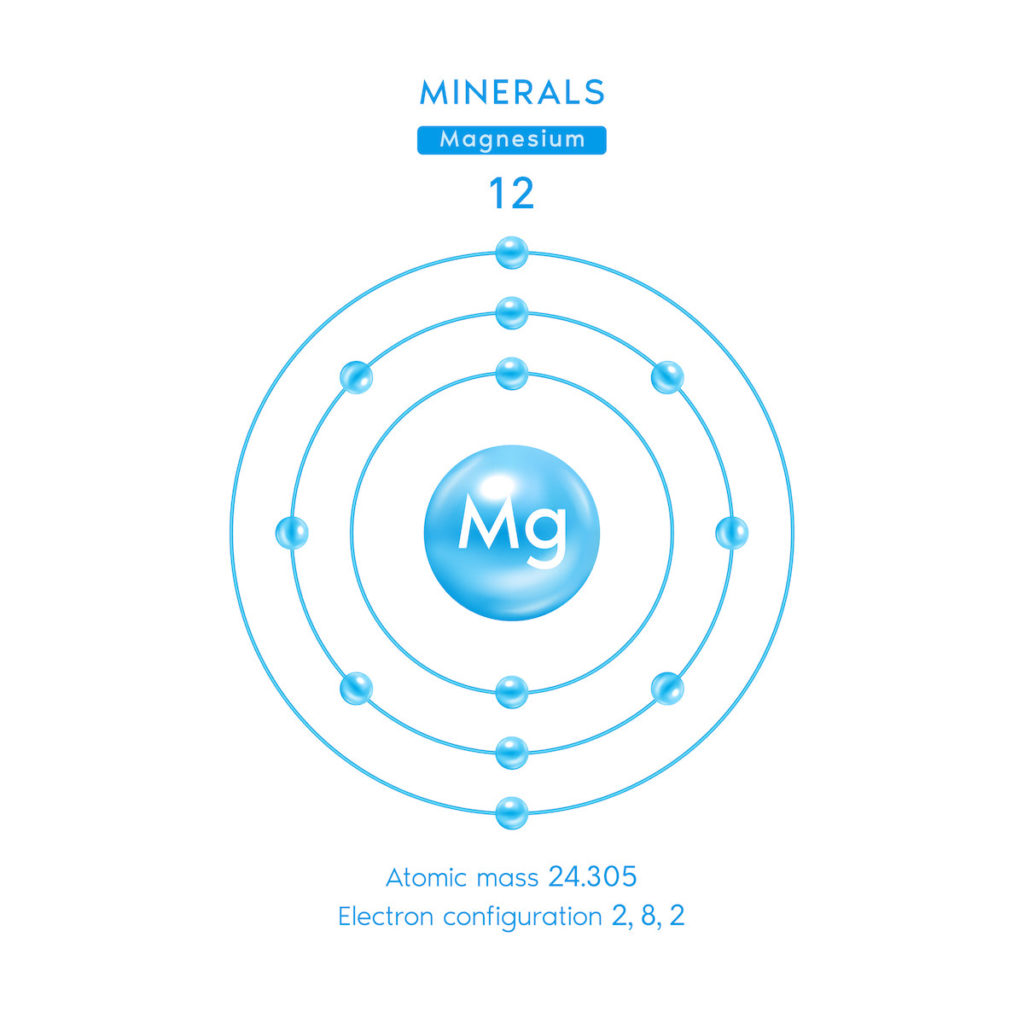Updated on 28. June 2022 from ÁYIO-Q Redaktion
Reading time: approx. 27 minutes
Magnesium – The most important mineral for a healthy life
Magnesium is vital for both plants and animals. Chlorophyll, a component of photosynthesis, is a complex porphyrin-magnesium molecule. In humans, magnesium plays a vital role in the body and brain by helping to control everything from blood sugar levels to increasing physical performance. Read on to learn all about the health benefits and discomfort associated with a magnesium deficiency in this article.
The Biological Role of Magnesium

Magnesium is a chemical element that is crucial for human health. Most magnesium is found in bones (about 50-60%), and its ions are crucial for the activity of several coenzymes and ATP-dependent processes. ATP (adenosine triphosphate) is a compound found in all living cells and is required for the production of RNA and to provide energy for other metabolic processes. In addition, magnesium stabilises the structural stability of DNA and RNA strands.
The human body uses magnesium for a variety of processes. It controls several important processes, including muscle contraction, neuromuscular transmission, regulation of blood sugar levels, contraction of the heart muscle and blood pressure by acting as a cofactor for hundreds of enzymes. In addition, magnesium is essential for the synthesis of nuclear materials, the generation of energy, the growth of bone and active transmembrane transport for other ions. [1]
Magnesium is involved in the repolarisation of neurons, the production of neurotransmitters and neuromodulators and the relaxation of muscles (its effect in the heart muscle is particularly important). There are several reasons for magnesium deficiency. The bloodstream absorbs magnesium from the cells, which is then excreted in the urine and/or faeces. The body loses magnesium faster the more it is under stress.
In addition, a number of diseases have been linked to magnesium deficiency. Numerous studies have also shown that a higher magnesium intake has positive effects. The magnesium cycle of the human body, magnesium deficiency and its causes, disorders associated with low magnesium levels, hypermagnesemia and the use of magnesium for treatment and prevention are discussed below.
Magnesium and Nutrition
The recommended daily amount of magnesium for adults is 420 mg for men and 320 mg for women, according to the United States Food and Nutrition Board. Water is a source of about 10% of the daily magnesium requirement. Magnesium is abundant in green vegetables, nuts, seeds and uncooked grains. In addition, foods such as fruit, seafood, meat and dairy products contain some magnesium. [2]
Due to the use of processed foods, demineralised water and agricultural techniques that use magnesium-poor soils to grow food, the majority of people in Western countries consume less magnesium than is recommended. [3]
Magnesium – Homeostasis
Magnesium homeostasis is regulated by the gut, bones and kidneys. Most magnesium is absorbed through a passive paracellular process in the ileum and distal parts of the jejunum but a small amount of magnesium is actively absorbed in the colon. Between 24 and 76 percent of the magnesium ingested with food is absorbed in the intestine, the rest is excreted with the faeces. Both the amount of magnesium ingested and the amount of magnesium present in the body affect how much is absorbed in the stomach. [4]

The kidneys are crucial for maintaining magnesium balance. About 2.4 grams of magnesium are filtered daily by the glomeruli. The ascending thick branch of the loop of Henle, which accounts for 65 per cent of the reabsorbed magnesium excretion, and the distal tubules, which account for the remainder, play an important role in this process (30 per cent). Depending on the amount of magnesium in the blood, the kidneys can regulate the amount excreted. The daily excretion of magnesium via the urine is only about 100 mg. [4]
Magnesium: Mechanisms of Action
Like other electrolytes, magnesium plays a variety of complex roles in the body. The respective organ system and the composition used determine how magnesium works.
Magnesium – Gastrointestinal
Oral magnesium promotes defecation through osmotic fluid retention. Over-the-counter antacids also contain it.
Based on a multinational study conducted in 2012, the effectiveness of prophylactic treatment with laxatives and antiemetics on the incidence of gastrointestinal side effects such as constipation, nausea and vomiting was investigated in cancer patients receiving oral opioid analgesics for the first time. According to the study, the 619 patients who received laxatives (including magnesium oxide) before taking opioids experienced significantly less constipation than patients who did not receive laxatives. Prophylactic laxatives significantly reduced the incidence of constipation, according to the meta-analysis of the results. [5]
Magnesium – Cardiovascular
Magnesium is a cofactor of the sodium-potassium pump, an electrogenic transmembrane that naturally blocks calcium channels. Excitation conduction in the atrioventricular node is regulated by magnesium. Due to the excitability of the heart muscle caused by hypomagnesemia, cardiac arrhythmias such as ventricular tachycardia and torsade de pointes (palpitations) can occur.
A 2014 cardiology study found that magnesium is involved in cellular mechanisms that control cardiovascular function. It is fundamental to the development of several cardiovascular diseases, including hypertension, atherosclerosis, coronary artery disease, heart failure and cardiac arrhythmias. It modulates vascular smooth muscle tone, endothelial cell activity and cardiac muscle excitability. This study highlights the current function of magnesium in the prevention and treatment of cardiovascular disease, as well as its vasodilatory, anti-inflammatory, anti-ischaemic and anti-arrhythmic effects. [6]
Magnesium – Nervous System
Magnesium not only has a calming effect on the central nervous system (CNS), but also has anticonvulsant properties. By preventing the release of acetylcholine at neuromuscular junctions, it prevents peripheral neuromuscular transmission.
According to a 2018 nutrient report, magnesium is crucial for nerve conduction and neuromuscular transmission from a neurological perspective. It protects against overexcitation, which can lead to neuronal death, and has been linked to a number of neurological diseases. Magnesium is a mineral of great importance for the possible prevention and treatment of neurological diseases, as it plays an essential role in the brain system. Magnesium has been found to be a potential target for the prevention and treatment of neurological disorders due to its mechanical aspects in neurological disorders. [7]
Magnesium – Reproductive System
During preterm labour, magnesium is used as a labour inhibitor. Magnesium promotes muscle relaxation and vasodilatation by stimulating calcium reuptake by the sarcoplasmic reticulum. Magnesium lowers the calcium level in the uterine muscle and thus prevents preterm labour.
The aim of a systematic study conducted in 2013 was to evaluate the effectiveness of magnesium maintenance therapy in preventing preterm birth after the first threatened preterm births had been stopped. The study participants were treated with magnesium after a threatened preterm birth in randomised controlled trials. In the late 1950s, magnesium was thought to affect uterine contractility by slowing down labour. It is still unclear how magnesium acts as a labour inhibitor, either initially or over time. By altering calcium uptake, binding and distribution in smooth muscle cells, magnesium reduces the frequency of smooth muscle depolarisation. The contractions of the uterus are thus ultimately inhibited. [8]
Magnesium – Respiratory System
The smooth muscles of the bronchial tubes can relax after an injection of magnesium. It is not known what causes the smooth muscle to relax. It is thought to work by either preventing the release of acetylcholine, histamine or calcium. Taking beta-agonists at the same time may possibly have a synergistic effect.
The efficacy of intravenous and nebulised magnesium sulphate in the treatment of adults and children with acute asthma was assessed in a 2013 systematic review and meta-analysis. Along with adrenergic agonists and systemic steroids, the use of intravenous magnesium sulphate in the treatment of acute asthma for children appears to offer benefits in terms of improving lung function and reducing the frequency of hospital admissions. However, inhalation of magnesium sulphate appears to offer benefits only in adults. [9]
Magnesium Haemostasis
About 50% of magnesium is found in bone, 25% in muscle and the remaining 25% in soft tissue, serum and red blood cells (RBCs). Like other electrolytes, it can be categorised as ionised, protein-bound or bound to anions. The most biologically active form of magnesium is ionised magnesium.
Magnesium homeostasis is maintained by the colon, the bones and the kidneys. Magnesium is absorbed by the colon, deposited in the bones and excreted by the kidneys, similar to calcium. Since the magnesium concentration in the body is inversely proportional to absorption, more magnesium is absorbed when magnesium levels are low.
A 2017 observational study examined the association between blood magnesium levels on admission and haematoma volume, haematoma growth and functional outcomes in patients with intracerebral haemorrhage (ICH). Lower magnesium levels on admission were associated with worse functional outcomes at 3 months after adjusting for age, Glasgow Coma Scale score on admission, initial haematoma volume, time from onset of symptoms to first computed tomography scan and haematoma growth. This result provides evidence that the effect of magnesium is mediated by haematoma growth. The data support the hypothesis that magnesium has a clinically significant effect on haemostasis in ICH patients, according to the study’s findings. [10]
Hypomagnesemia
Magnesium insufficiency or hypomagnesaemia is characterised by too low a level of the mineral in the blood. More specifically, a low level of serum magnesium (less than 1.46 mg/dL) in the blood results in an electrolyte disturbance. Hypomagnesaemia is a common electrolyte disturbance in the clinical setting, especially in patients referred to the intensive care unit, where it is associated with higher mortality and longer hospital stay. [11]

Symptoms of Hypomagnesemia
The symptoms of magnesium deficiency can be vague and often occur simultaneously with those of other electrolyte disorders. The degree of magnesium deficiency and the rate of magnesium reduction determine how severe the symptoms and indicators are. When the blood magnesium concentration falls below 1.2 mg/dL, symptoms are common. Any system, including the neuromuscular, cardiovascular, renal and gastrointestinal systems, can be affected by the clinical signs of hypomagnesaemia. [12]
Causes of Hypomagnesemia
There are two types of causes of hypomagnesaemia: hereditary and acquired. Acquired causes include decreased oral intake or gastrointestinal absorption, accelerated renal excretion or redistribution due to severe disease. There is also evidence that different drugs affect serum magnesium levels in different ways.
Reduced intake
Due to food processing and the use of low-quality soils for agriculture, several nutritional studies have found that people in North America and Europe consume less magnesium than the recommended daily allowance (RDA). In addition, prolonged nasogastric aspiration, total parenteral (intravenous) nutrition and fasting for prolonged periods can lead to hypomagnesaemia. [13]
Poor absorption in the digestive tract
The absorption of magnesium ions in the case of low dietary magnesium intake depends strongly on active transcellular uptake by magnesium ion-specific transporters in the colon. Numerous diseases such as chronic diarrhoea, pancreatic insufficiency, coeliac disease, persistent alcoholism, inflammatory bowel disease and small bowel syndrome can lead to impaired gastrointestinal absorption of magnesium. [12]
Intracellular magnesium shift and redistribution
Saponification in acute pancreatitis associated with fat necrosis may lead to hypomagnesaemia. In addition, the distribution of magnesium in cells can change under certain circumstances. These include pregnancy, breastfeeding, refeeding syndrome and cardiopulmonary surgery. Massive blood transfusions often lead to hypomagnesaemia, which is thought to be caused by haemodilution, comorbidities, citrate toxicity and/or other factors. [12]
Development of magnesium kidney damage
Hypokalaemia, hypercalcaemia and hypophosphataemia can all lead to decreased renal reabsorption of magnesium. Hypomagnesaemia and reversible renal tubular dysfunction have been associated with chronic alcohol consumption. In addition, a number of hereditary diseases and medications have been associated with decreased renal reabsorption of magnesium. [14]
Hypomagnesemia caused by medication
Hypomagnesaemia has been associated with almost 50 different medicines. The most commonly administered drugs associated with hypomagnesaemia are listed below. [15,16,17]
- Antibiotics, so-called aminoglycosides, reduce renal tubular reabsorption and/or cause acute tubular necrosis (ATN).
- Amphotericin B reduces magnesium absorption and has harmful effects on the kidneys.
- Magnesium reabsorption is impaired by anti-epidermal growth factor (EGF) receptors, such as cetuximab.
- Calcineurin inhibitors, such as tacrolimus and cyclosporine, interfere with the absorption of magnesium;
- Platinum derivatives (such as cisplatin and carboplatin) affect the absorption of magnesium.
- Diuretics with loop and thiazide effects reduce magnesium absorption.
- Pentamidine reduces the absorption of magnesium.
- Magnesium permeability channel transporters are downregulated by proton pump inhibitors (PPIs), which reduce magnesium absorption in the gut.
Critically Ill Patients with Hypomagnesaemia
According to several observational studies, hypomagnesaemia affects a relatively large number of critically ill patients admitted to the ICU. It is more common in postoperative ICU patients. Malnutrition, diabetes mellitus, other electrolyte abnormalities (such as hypokalaemia and hypocalcaemia), medications and reduced magnesium absorption due to impaired gastrointestinal activity are just some possible explanations for hypomagnesaemia in critically ill patients (e.g. loop diuretics, gentamycin and proton pump inhibitors).
The importance of serum magnesium levels in critically ill patients was studied in 2014 in an international journal of applied and basic medical research. According to the research, magnesium is one of the most important electrolytes, the deficiency of which is usually ignored in critically ill patients and can have negative clinical consequences if not constantly checked. It was found that critically ill people often have a major electrolyte problem, in this particular case hypomagnesaemia. Critically ill people with hypomagnesaemia are more likely to die than patients with normal hypomagnesaemia. [18]
Another systematic review and meta-analysis on hypomagnesaemia and mortality in ICU patients was conducted in 2016, and the results showed that claims of deaths attributable to magnesium dysregulation in ICU care are controversial. The study examined the association between hypomagnesaemia and patient mortality in the ICU. The results of this meta-analysis show that hypomagnesaemia is associated with increased mortality, need for mechanical ventilation and length of stay of patients in the ICU. [19]
Due to the high incidence of hypomagnesaemia in ICU patients, constant monitoring of blood magnesium levels is recommended. Intravenous administration of magnesium sulphate has been shown to have antiarrhythmic and neuroprotective effects and may be associated with a reduction in mortality and length of stay in the ICU. [20]
Magnesium Levels in Hospitalised Patients: Hypo- and Hypermagnesemia
The prevalence of hypo- and hypermagnesaemia in general hospitalised patients, including those not in intensive care, has been studied in only a small number of research papers. In contrast, the increasing tendency to take magnesium supplements in this group as a result of increased awareness of the beneficial effects of magnesium on the cardiovascular system has been frequently observed in patients with cardiovascular disease which can be explained by the observation of hypermagnesaemia in these patients.
The incidence and prognostic significance of dysmagnesemia in hospitalised patients were studied, according to the journal Proceedings of the Mayo Clinic. The aim of the study was to determine the extent of serum magnesium changes and their impact in hospitalised individuals. All admissions to the Mayo Clinic in Rochester, Minnesota, from 1 January 2009 to 31 December 2013, involving 288120 patients, were studied. The facility’s computerised database was used to determine each patient’s magnesium levels on admission and relevant clinical information. Dysmagnesaemia, with hypermagnesaemia being the most common form, was found to be prevalent in hospitalised patients. Hypermagnesaemia is a better indicator of adverse outcomes than hypomagnesaemia. In the absence of randomised controlled trials demonstrating benefit, magnesium supplementation should be avoided in patients without magnesium insufficiency. [11]
Hypermagnesemia
Maintaining the limited range of normal plasma magnesium levels is critical for the kidney. Hypermagnesemia is a rare condition that can develop without magnesium injection or kidney disease. In this case, the patient usually shows no symptoms and the increase in plasma magnesium is often small. However, if the plasma magnesium level is very high, clinical signs may be observed.
Although hypermagnesaemia is usually rare, it can occur in up to one third of hospitalised patients and, like hypomagnesaemia, is associated with increased mortality and prolonged hospitalisation. Iatrogenic hypermagnesaemia is often associated with gastrointestinal disease, advanced age and impaired renal function. Lithium medications, hypothyroidism, Addison’s disease, familial hypocalciuric hypercalcaemia and lactic alkali syndrome are some rarer causes of hypermagnesaemia. Depending on the serum magnesium level, hypermagnesaemia can have different clinical effects, as shown below. [13]
| Serum Magnesium | Clinical signs |
| Moderately high | Nausea, ileus, vomiting, facial flushing, urinary retention and hypotension. |
| High | Complete heart block, drowsiness and absence of deep tendon reflex. |
| Very high | Impairment of the respiratory system, paralysis and complete cardiac arrest. |
| Extreme | Asystole (cardiac arrest). |
Causes of Hypermagnesemia
When renal function is impaired, a high amount of magnesium is administered intravenously, orally or as an enema, or there is increased absorption from the digestive tract due to constipation, colitis, gastritis or gastric ulcers. These three situations are the main causes of hypermagnesaemia. The neuromuscular blocking properties of magnesium are enhanced by hypermagnesaemia, which also increases gastrointestinal magnesium absorption and the resulting hypermagnesaemia. [22]
Decreased Renal Excretion
Patients with acute or chronic kidney disease have a higher risk of developing hypermagnesaemia. Some factors, such as proton pump inhibitors, malnutrition and alcohol consumption, may increase the risk of hypermagnesaemia in these people. Other known causes include hypothyroidism and adrenocortical insufficiency in particular.
Due to increased calcium-induced magnesium absorption in the tubule, hyperparathyroidism and alterations in calcium metabolism, including hypercalcaemia and/or hypocalciuria, may cause hypermagnesaemia. Hypermagnesaemia may occur in people with familial hypocalciuric hypercalcaemia (FHH), a rare autosomal dominant disorder. [23]
By reducing excretion, lithium-based psychotropic drugs can potentially cause hypermagnesaemia.
Increased Intake
In rare cases, the syndrome may occur without renal failure, usually in the elderly, when an underlying intestinal problem may lead to increased absorption via decreased gastrointestinal motility. Patients taking opioids or anticholinergic medications or those with inflammatory bowel disease are more susceptible. [24]
Magnesium levels may increase after taking some medications, such as laxatives and magnesium-containing antacids (e.g. magnesium oxide), especially in older people with impaired kidney function. Magnesium oxide, for example, is relatively safe because of its low bioavailability, but prolonged use may increase the risk of hypermagnesaemia. In geriatric patients receiving prolonged magnesium oxide therapy, regular screening is recommended. Nevertheless, taking less than 1 g of magnesium oxide per day appears to be reasonably safe. [25]
Capillary Shift or Leakage (Compartment Syndrome)
Higher magnesium levels may occur in patients with haemolysis. The magnesium content in red blood cells is three times higher than in plasma. Magnesium enters the plasma when these cells burst. However, symptomatic hypermagnesemia can only occur in the case of severe haemolysis.
Due to extracellular changes, tumour lysis syndrome, rhabdomyolysis and acidosis (e.g. decompensated diabetes with ketoacidosis) can also cause hypermagnesemia.
Hypomagnesemia and Endocrine Diseases
Diabetes Mellitus
Magnesium is a crucial cofactor for several enzymes involved in carbohydrate metabolism. Through post-translational modification of insulin receptor protein and control of tyrosine kinase activity on these receptors, magnesium acts as an insulin sensitizer. Increased calcium entry into adipocytes as a result of decreased intracellular magnesium can cause oxidative stress, inflammation and increased insulin resistance.
A diet low in magnesium was found to be closely associated with reduced insulin-dependent glucose uptake and an increase in the prevalence of diabetes mellitus. Lower magnesium levels were found in patients with type 1 diabetes mellitus than in healthy people. In addition, low lipid profiles, increased risk of atherosclerosis and poor glycaemic management have been associated with hypomagnesaemia. [26]
A summary of recent lectures on magnesium and diabetes mellitus was prepared as part of a clinical nutrition study. Magnesium deficiency is associated with chronic diseases such as diabetes mellitus. Epidemiological studies have drawn attention to the low consumption of magnesium in the general population and to the association between the consumption of magnesium-rich foods and a lower prevalence of diabetes and its consequences. Although hypomagnesaemia is common in diabetics, it is still unclear exactly how magnesium deficiency develops in diabetes mellitus. [27]
Instead, it has been found that poor metabolic control in diabetes mellitus can affect magnesium levels in the body, leading to hypomagnesaemia, which in turn can be directly related to some micro- and macrovascular complications of diabetes, including cardiovascular disease, retinopathy and neuropathy. As a result, diabetes-related long-term problems can manifest rapidly. Magnesium supplementation is recommended for people with diabetes mellitus who have been shown to have hypomagnesaemia and its associated effects. [27]
Metabolic Syndrome
Numerous studies have linked metabolic syndrome and chronic inflammation to hypomagnesaemia. Hypomagnesaemia is thought to cause free radical formation and low-grade chronic inflammation. Alterations in magnesium metabolism are also associated with metabolic syndrome. Recently, it has been found that people with type 2 diabetes who also have a high-risk lipid profile, high blood pressure or abdominal obesity had lower levels of circulating ionised magnesium.
One of these different assessments highlighted that the lack of magnesium in the cells and extracellular space is a hallmark of type 2 diabetes. Important metabolic regulators of magnesium include insulin and glucose. A common mechanism for insulin resistance in several metabolic disorders has been suspected: magnesium deficiency. Type 2 diabetes is also associated with low dietary magnesium intake. In the majority of subjects, magnesium supplementation had a significant positive effect on their metabolic profile while they were diabetic. [28]
Osteoporosis
About 60% of the body’s total magnesium is stored in the bones, 30% of which is skeletal magnesium found in the hydration shell or on the surface of hydroxyapatite. The serum magnesium can exchange with the magnesium found on the bone surface. The release of the remaining skeletal magnesium, which is an essential component of bone, depends on bone resorption.
It appears that maintaining stable magnesium homeostasis is essential for bone health. Both low and high magnesium levels have negative effects on bone, according to experimental and epidemiological research. Magnesium deficiency impairs bone cells and crystal formation, which directly affects osteoporosis. Indirectly, it also affects the release and activity of parathyroid hormones, leading to an increase in low grade inflammation. The processes leading to the mineralisation deficits that occur with elevated magnesium levels are less well understood. Overall, regulating and maintaining magnesium homeostasis is a beneficial strategy for maintaining bone integrity.
Most experimental and clinical data in the literature suggest that magnesium contributes to bone health, although the evidence is still shaky. Therefore, optimising magnesium intake could be an effective and affordable preventive measure against osteoporosis in people with proven magnesium deficiency, although there are still concerns about supplementing the general population with the mineral, as too much magnesium seems to have negative effects on bones. [29]
Cardiovascular Health: Hypo- and Hypermagnesemia
By influencing vascular tone, peripheral vascular resistance and endothelial function, magnesium plays a crucial role in controlling heart rhythm. The following is an overview of the effects of magnesium on cardiovascular health, as already described in the mechanisms of action.
Magnesium has a positive effect on the cardiovascular system:
- Endothelial function has improved
- Direct and indirect induction of vasodilatation
- Improvement of blood pressure
- Favourable effects on inflammatory reactions, cardiac arrhythmias and platelet aggregation
- Potential impact on people with stable coronary artery disease in terms of increasing exercise capacity
- Improvement of lipid metabolism and insulin homeostasis
- Reduces thrombosis and platelet activation
- Reduces excess calcium in the coronary arteries, which reduces damage to cells from ischaemia
Cardiac Arrhythmia
The following potential mechanisms may explain why hypomagnesaemia is associated with an increased risk of cardiac arrhythmias:
- Magnesium deficiency impairs the sodium-potassium pump, causing intracellular potassium levels to decrease and intracellular sodium levels to increase, resulting in a less negative resting membrane potential;
- reduced effect of magnesium against calcium at the atrioventricular node.
Both mechanisms increase susceptibility to cardiac arrhythmias by causing unstable membrane potentials, impulse conduction and impulse transmission. [30]
As part of a systematic review and meta-analysis focused on the prevention of cardiac arrhythmias, magnesium was to be investigated as prophylaxis or therapy of postoperative arrhythmias in cardiac surgery patients. More specifically, the effects on biochemical and patient-centred outcomes were to be assessed. According to the results of the study, magnesium supplementation after cardiac surgery appears to reduce atrial fibrillation, a disorder of the heart that results in an irregular and often excessively high heart rate, without significant adverse effects. [31]
Coronary Heart Disease
The importance of magnesium for the risk of developing coronary artery disease is well established by the available research. In addition, treatment of hypomagnesaemia is critical for individuals with acute myocardial ischaemia to avoid cardiac arrhythmias. Consumption of water with a high magnesium content can reduce deaths related to cardiovascular disease by 30-35 per cent, according to a previous study. Cardiovascular disease and possibly many other health problems can be prevented by adding 25 to 50 ppm of magnesium to drinking water. [32]
In people with coronary artery disease, oral magnesium treatment improves endothelial function, a clinical trial has found. The results of the current study showed that in a cohort of people with stable coronary artery disease, six months of oral magnesium treatment resulted in a significant improvement in endothelial function of the brachial artery. The magnesium ion data show a moderate correlation between magnesium ions and brachial artery endothelial function at baseline and a significant increase in magnesium ions in response to oral magnesium therapy, which was associated with an improvement in brachial artery endothelial function. [33]
High Blood Pressure
The aetiology of hypertension may include low dietary magnesium levels and hypomagnesaemia. By enhancing the vasodilatory effects of nitric oxide, counteracting the vasoconstrictor effects of calcium, bradykinin, angiotensin II, serotonin and prostaglandin, and preserving the vascular endothelium through its antioxidant effects, magnesium lowers vascular tone and resistance. [34]
Epidemiological and experimental studies have shown an inverse relationship between blood pressure and serum magnesium levels, suggesting that magnesium deficiency may play a role in the pathophysiology of hypertension. A 2006 review addresses the function of magnesium in controlling blood pressure and vascular function and the effects of magnesium deprivation on experimental and real-world hypertension. Epidemiological studies have linked low-magnesium “soft water” to hypertension and heart disease, and protective “hard water” to cardiovascular health. There is growing evidence that inadequate magnesium levels may be pathophysiologically responsible for the development of hypertension. [35]
Pre-Eclampsia
Pre-eclampsia and eclampsia are traditionally treated with intravenous magnesium sulphate. The vasodilatory effects of magnesium in blood vessels and its involvement in preventing oxidative damage in severe pre-eclampsia can be used to understand the underlying mechanisms of action. According to the research, magnesium sulphate interacts with alkyl radicals to protect plasma membranes from oxidative damage. [36]
Magnesium levels in women with pre-eclampsia may be normal or decreased, according to a study of the processes behind the effects of magnesium salts. However, the pathophysiological effects of eclampsia and pre-eclampsia with severe features can be alleviated by taking magnesium salts such as magnesium sulphate. The research results available today show that magnesium has a positive effect on the mother and the foetus, even though the mechanism of action of this magnesium salt is not yet fully understood. Maintenance of magnesium homeostasis is essential for good pregnancy development. For this reason, the negative effects of this condition on the mother, the foetus and the infant can be alleviated by taking oral magnesium salts. [37]
Heart Failure
Patients with congestive heart failure are more likely to have low blood potassium and magnesium levels for several reasons. Poor oral intake, impaired gastrointestinal absorption, persistent overstimulation of the renin-angiotensin-aldosterone system and use of medications such as diuretics are some of them. [38]
A comprehensive review and meta-analysis published in 2016 examined the association between blood magnesium levels and mortality in people with heart failure. Low serum magnesium levels have been shown to increase the risk of heart failure, although research on the relationship between blood magnesium levels and outcomes in people with heart failure is conflicting. The researchers found that, unlike hypomagnesaemia, serum hypermagnesaemia was associated with an increased risk of cardiovascular and overall death in patients with heart failure. [39]
Hypomagnesemia and Neurological Diseases
Extracellular magnesium inhibits the release of glutamate from neurons rich in NMDA receptors and from NMDA receptors. NMDA receptors are a class of L-glutamate receptors known to be essential for spatial memory and play an important role in learning and remembering. Low extracellular magnesium levels can cause NMDA-coupled calcium channels to open abnormally, resulting in increased calcium influx, increased neuronal excitability and increased formation of harmful nitric oxide radicals. [40]
Headache
Low magnesium levels and migraines are associated through a number of processes. Low magnesium levels can lead to platelet aggregation and the release of serotonin, which can constrict blood vessels and cause a severe migraine. In addition, decreased magnesium levels lead to an increase in extracellular potassium, NMDA receptor activation, intracellular calcium, glutamate release and neuronal excitability, resulting in impaired cortical spread. Compared to a healthy group of subjects, the average serum magnesium level is significantly lower in migraine patients. [41]
In 2020, a study was conducted on the causes, bioavailability, therapeutic efficacy and likely benefits of magnesium epidolate and headache. The study covered the cellular and molecular consequences of magnesium deficiency in the brain, as well as the scientific data supporting the use of magnesium as a headache and migraine therapy. The results support the link between magnesium deficiency and headaches. They also suggest that magnesium deficiency may act as an independent risk factor for migraine. Studies from the 1990s are included in this review in some cases. [42]
Seizures
Magnesium sulphate is the drug of choice for the treatment and prevention of seizures in women with pre-eclampsia and eclampsia. Some research suggests that oral magnesium supplements may be helpful when taken in conjunction with other medications to treat drug-resistant epilepsy. Magnesium’s ability to block NMDA glutamate receptors, increase the production of vasodilatory prostaglandins and stabilise the neuronal membrane can be used to explain its anticonvulsant effects. [43]
In 2012, magnesium was investigated as an effective tool for the treatment of drug-resistant seizures. The aim was to investigate the use of magnesium, an endogenous ion and enzymatic co-factor, to treat epileptic seizures resistant to conventional medical treatment. The results of the study showed that oral magnesium supplementation was associated with a significant reduction in monthly seizure days. These results suggest that oral magnesium supplementation may be an effective adjunctive therapy for the treatment of drug-resistant epilepsy. [44]
Hypomagnesemia and Respiratory Diseases
The exact mechanism of action of magnesium to improve lung function is not known, but it is likely that magnesium works through an anti-inflammatory effect that reduces inflammation in the lungs, as well as by controlling the bronchial constrictors acetylcholine and histamine, and through a vasodilator and bronchodilator effect. [3]
Bronchial Asthma
The function of magnesium to counteract the effects of calcium and alter intracellular signalling is thought to be the mechanism of action of magnesium sulphate in helping to reduce airway inflammation in asthma. This reduces the neutrophil respiratory burst. A single dose of intravenous magnesium sulphate has been suggested for the treatment of acute, severe and life-threatening asthma exacerbations. [45]
In the Egyptian Journal of Chest Diseases and Tuberculosis, serum magnesium levels were studied in patients with bronchial asthma under stable and worsening clinical conditions. According to the results of the study, individuals with both chronic stable asthma and acute asthma exacerbations had lower magnesium levels than the control group. Blood magnesium levels were found to be significantly lower in asthma patients than in healthy controls and significantly lower during asthma exacerbation than in stable asthma. [46]
Magnesium Disorders and Kidney Disease
Magnesium homeostasis is significantly influenced by the kidney. To compensate for the loss of glomerular filtration, mild to moderate renal dysfunction can increase the fractional excretion of magnesium. Hypermagnesaemia develops when this compensatory system is unable to maintain the body in a state of homeostasis due to extensive chronic kidney disease. [47]
An overview of the epidemiological associations between magnesium and overall and cardiovascular survival in people with chronic kidney disease is provided in a 2019 review. According to the results of the study, there is a consistent inverse association between blood magnesium levels and all-cause and cardiovascular mortality in both patients with chronic kidney disease who do not receive dialysis and those who undergo haemodialysis or peritoneal dialysis. Due to factors common to patients with chronic kidney disease, such as dietary potassium restriction, consumption of processed foods, use of proton pump inhibitors and low magnesium concentrations in the dialysate, these patients are at risk for absolute or relative magnesium deficiency. Therefore, patients with chronic kidney disease and low serum magnesium levels need to be managed carefully. [48]
Administration of Magnesium
There are different ways to supply magnesium. For a healthy person, intake through food is the main source of magnesium. Magnesium is available as magnesium oxide, magnesium citrate, magnesium sulphate, magnesium hydroxide and magnesium gluconate, among others.
- Treatment options include intravenous magnesium sulphate, intramuscular magnesium sulphate and oral magnesium salts. In people with severe hypomagnesaemia or those who cannot tolerate or comply with oral treatment, magnesium sulphate is given intravenously or intramuscularly.
- To prevent hypomagnesaemia, patients with alcohol problems are treated empirically. In persons with renal insufficiency, the doctor must increase the dose to account for the increased renal loss.
- Simultaneous hypokalaemia or hypocalcaemia must also be treated by the doctor.
Side Effects of Magnesium
Depending on the exact formulation, adverse effects are associated with the action of magnesium on the neuromuscular and cardiovascular systems. The following effects are possible:
Serious negative incidents:
- Cardiovascular collapse
- Respiratory paralysis or depression
- Hypothermia
- Decreased efficiency of the heart
- Edema in the lungs
Typical negative consequences:
- Flushing (reddening of the skin)
- Hypotension
- Vasodilation
- Weakened reflexes
- Stomach pain
- Diarrhoea
- Flatulence
- Nausea/vomiting
- Respiratory depression
- Disturbed electrolytes (hypocalcaemia, hyperkalaemia)
- Hypermagnesemia
In terms of effects on the heart, hypermagnesemia can be a significant impairment.
sources:
[1] Gröber U, Schmidt J, Kisters K. Magnesium in Prevention and Therapy. Nutrients. 2015;7(9):8199-8226. Published 2015 Sep 23. doi:10.3390/nu7095388. Verfügbar unter: https://www.mdpi.com/2072-6643/7/9/5388/htm
[2] Institute of Medicine (IOM). Food and Nutrition Board. Dietary Reference Intakes: Calcium, Phosphorus, Magnesium, Vitamin D and Fluoride. Washington, DC: National Academy Press, 1997. Verfügbar unter: http://www.nap.edu/openbook.php?record_id=5776
[3] de Baaij JH, Hoenderop JG, Bindels RJ. Magnesium in man: implications for health and disease. Physiol Rev. 2015;95(1):1-46. doi:10.1152/physrev.00012.2014. Verfügbar unter: https://journals.physiology.org/doi/full/10.1152/physrev.00012.2014?rfr_dat=cr_pub++0pubmed&url_ver=Z39.88-2003&rfr_id=ori%3Arid%3Acrossref.org
[4] Jahnen-Dechent, Wilhelm, and Markus Ketteler. “Magnesium basics.” Clinical kidney journal vol. 5,Suppl 1 (2012): i3-i14. doi:10.1093/ndtplus/sfr163. Verfügbar unter: https://academic.oup.com/ckj/article/5/Suppl_1/i3/447534
[5] Ishihara, Masashi et al. “A multi-institutional study analyzing effect of prophylactic medication for prevention of opioid-induced gastrointestinal dysfunction.” The Clinical journal of pain vol. 28,5 (2012): 373-81. doi:10.1097/AJP.0b013e318237d626. Verfügbar unter: https://journals.lww.com/clinicalpain/Abstract/2012/06000/A_Multi_institutional_Study_Analyzing_Effect_of.1.aspx
[6] Kolte, Dhaval et al. “Role of magnesium in cardiovascular diseases.” Cardiology in review vol. 22,4 (2014): 182-92. doi:10.1097/CRD.0000000000000003. Verfügbar unter: https://www.researchgate.net/profile/Dhaval-Kolte/publication/262874942_Role_of_Magnesium_in_Cardiovascular_Diseases/links/0f31753cb28079d678000000/Role-of-Magnesium-in-Cardiovascular-Diseases.pdf
[7] Kirkland, Anna E et al. “The Role of Magnesium in Neurological Disorders.” Nutrients vol. 10,6 730. 6 Jun. 2018, doi:10.3390/nu10060730. Verfügbar unter: https://www.mdpi.com/2072-6643/10/6/730/htm
[8] Han, Shanshan et al. “Magnesium maintenance therapy for preventing preterm birth after threatened preterm labour.” The Cochrane database of systematic reviews vol. 2013,5 CD000940. 31 May. 2013, doi:10.1002/14651858.CD000940.pub3. Verfügbar unter: https://www.cochranelibrary.com/cdsr/doi/10.1002/14651858.CD000940.pub3/full
[9] Shan, Zhilei et al. “Intravenous and nebulized magnesium sulfate for treating acute asthma in adults and children: a systematic review and meta-analysis.” Respiratory medicine vol. 107,3 (2013): 321-30. doi:10.1016/j.rmed.2012.12.001. Verfügbar unter: https://www.sciencedirect.com/science/article/pii/S0954611112004519
[10] Liotta, Eric M et al. “Magnesium, hemostasis, and outcomes in patients with intracerebral hemorrhage.” Neurology vol. 89,8 (2017): 813-819. doi:10.1212/WNL.0000000000004249. Verfügbar unter: https://www.ncbi.nlm.nih.gov/pmc/articles/PMC5580864/
[11] Cheungpasitporn, Wisit et al. “Dysmagnesemia in Hospitalized Patients: Prevalence and Prognostic Importance.” Mayo Clinic proceedings vol. 90,8 (2015): 1001-10. doi:10.1016/j.mayocp.2015.04.023. Verfügbar unter: https://www.mayoclinicproceedings.org/article/S0025-6196(15)00425-5/fulltext
[12] Pham, Phuong-Chi T et al. “Hypomagnesemia: a clinical perspective.” International journal of nephrology and renovascular disease vol. 7 219-30. 9 Jun. 2014, doi:10.2147/IJNRD.S42054. Verfügbar unter: https://www.dovepress.com/hypomagnesemia-a-clinical-perspective-peer-reviewed-fulltext-article-IJNRD
[13] Seo, Jang Won, and Tae Jin Park. “Magnesium metabolism.” Electrolyte & blood pressure : E & BP vol. 6,2 (2008): 86-95. doi:10.5049/EBP.2008.6.2.86. Verfügbar unter: https://www.ncbi.nlm.nih.gov/pmc/articles/pmid/24459527/
[14] Agus, Z S. “Hypomagnesemia.” Journal of the American Society of Nephrology : JASN vol. 10,7 (1999): 1616-22. doi:10.1681/ASN.V1071616. Verfügbar unter: https://jasn.asnjournals.org/content/10/7/1616.long
[15] Gradon, J D et al. “Severe hypomagnesemia associated with pentamidine therapy.” Reviews of infectious diseases vol. 13,3 (1991): 511-2. doi:10.1093/clinids/13.3.511. Verfügbar unter: https://pubmed.ncbi.nlm.nih.gov/1866558/
[16] Atsmon, Jacob, and Eran Dolev. “Drug-induced hypomagnesaemia : scope and management.” Drug safety vol. 28,9 (2005): 763-88. doi:10.2165/00002018-200528090-00003. Verfügbar unter: https://dx.doi.org/10.2165/00002018-200528090-00003
[17] Sivakumar, Jonathan. “Proton pump inhibitor-induced hypomagnesaemia and hypocalcaemia: case review.” International journal of physiology, pathophysiology and pharmacology vol. 8,4 169-174. 25 Dec. 2016. Verfügbar unter: https://www.ncbi.nlm.nih.gov/pmc/articles/pmid/28078056/
[18] Zafar, Mir Sadaqat Hassan et al. “Significance of serum magnesium levels in critically ill-patients.” International journal of applied & basic medical research vol. 4,1 (2014): 34-7. doi:10.4103/2229-516X.125690. Verfügbar unter: https://journals.lww.com/ijab/pages/default.aspx
[19] Upala, Sikarin et al. “Hypomagnesemia and mortality in patients admitted to intensive care unit: a systematic review and meta-analysis.” QJM : monthly journal of the Association of Physicians vol. 109,7 (2016): 453-459. doi:10.1093/qjmed/hcw048. Verfügbar unter: https://academic.oup.com/qjmed/article/109/7/453/1752946
[20] Panahi, Yunes et al. “The role of magnesium sulfate in the intensive care unit.” EXCLI journal vol. 16 464-482. 5 Apr. 2017, doi:10.17179/excli2017-182. Verfügbar unter: https://www.excli.de/vol16/Panahi_05042017_proof.pdf
[22] Nishikawa, Mana et al. “The characteristics of patients with hypermagnesemia who underwent emergency hemodialysis.” Acute medicine & surgery vol. 5,3 222-229. 21 Feb. 2018, doi:10.1002/ams2.334. Verfügbar unter: https://onlinelibrary.wiley.com/doi/10.1002/ams2.334
[23] Horino, Taro et al. “A Rare Presentation of Hypermagnesemia Associated with Acute Kidney Injury due to Hypercalcemia.” Internal medicine (Tokyo, Japan) vol. 58,8 (2019): 1123-1126. doi:10.2169/internalmedicine.1927-18. Verfügbar unter: https://www.jstage.jst.go.jp/article/internalmedicine/58/8/58_1927-18/_pdf/-char/en
[24] Shoaib Khan, Muhammad et al. “Fatal Hypermagnesemia: an acute ingestion of Epsom Salt in a patient with normal renal function.” Caspian journal of internal medicine vol. 9,4 (2018): 413-415. doi:10.22088/cjim.9.4.413. Verfügbar unter: https://pdfs.semanticscholar.org/c78c/7bc680f824d98943a722b5e459239e0163cd.pdf
[25] Mori, Hideki et al. “Clinical features of hypermagnesemia in patients with functional constipation taking daily magnesium oxide.” Journal of clinical biochemistry and nutrition vol. 65,1 (2019): 76-81. doi:10.3164/jcbn.18-117. Verfügbar unter: https://www.jstage.jst.go.jp/article/jcbn/65/1/65_18-117/_pdf/-char/en
[26] Lin, Ching-Chiang, and Yeou-Lih Huang. “Chromium, zinc and magnesium status in type 1 diabetes.” Current opinion in clinical nutrition and metabolic care vol. 18,6 (2015): 588-92. doi:10.1097/MCO.0000000000000225. Verfügbar unter: https://journals.lww.com/co-clinicalnutrition/Abstract/2015/11000/Chromium,_zinc_and_magnesium_status_in_type_1.11.aspx
[27] Sales, Cristiane Hermes, and Lucia de Fatima Campos Pedrosa. “Magnesium and diabetes mellitus: their relation.” Clinical nutrition (Edinburgh, Scotland) vol. 25,4 (2006): 554-62. doi:10.1016/j.clnu.2006.03.003. Verfügbar unter: https://www.sciencedirect.com/science/article/abs/pii/S0261561406000732
[28] Barbagallo, Mario, and Ligia J Dominguez. “Magnesium metabolism in type 2 diabetes mellitus, metabolic syndrome and insulin resistance.” Archives of biochemistry and biophysics vol. 458,1 (2007): 40-7. doi:10.1016/j.abb.2006.05.007. Verfügbar unter: https://www.sciencedirect.com/science/article/abs/pii/S0003986106001895
[29] Castiglioni, Sara et al. “Magnesium and osteoporosis: current state of knowledge and future research directions.” Nutrients vol. 5,8 3022-33. 31 Jul. 2013, doi:10.3390/nu5083022. Verfügbar unter: https://www.mdpi.com/2072-6643/5/8/3022/htm
[30] Del Gobbo, Liana C et al. “Low serum magnesium concentrations are associated with a high prevalence of premature ventricular complexes in obese adults with type 2 diabetes.” Cardiovascular diabetology vol. 11 23. 9 Mar. 2012, doi:10.1186/1475-2840-11-23. Verfügbar unter: https://cardiab.biomedcentral.com/articles/10.1186/1475-2840-11-23
[31] Fairley, Jessica L et al. “Magnesium status and magnesium therapy in cardiac surgery: A systematic review and meta-analysis focusing on arrhythmia prevention.” Journal of critical care vol. 42 (2017): 69-77. doi:10.1016/j.jcrc.2017.05.038. Verfügbar unter: https://www.sciencedirect.com/science/article/abs/pii/S0883944116310474
[32] Monarca, S et al. “Durezza dell’acqua potabile e malattie cronico-degenerative. Parte II. Malattie cardiovascolari” [Drinking water hardness and chronic degenerative diseases. II. Cardiovascular diseases]. Annali di igiene : medicina preventiva e di comunita vol. 15,1 (2003): 41-56. Verfügbar unter: https://pubmed.ncbi.nlm.nih.gov/12666324/
[33] Shechter, M et al. “Oral magnesium therapy improves endothelial function in patients with coronary artery disease.” Circulation vol. 102,19 (2000): 2353-8. doi:10.1161/01.cir.102.19.2353. Verfügbar unter: https://www.ahajournals.org/doi/full/10.1161/01.CIR.102.19.2353
[34] Paravicini, Tamara M et al. “Dysregulation of vascular TRPM7 and annexin-1 is associated with endothelial dysfunction in inherited hypomagnesemia.” Hypertension (Dallas, Tex. : 1979) vol. 53,2 (2009): 423-9. doi:10.1161/HYPERTENSIONAHA.108.124651. Verfügbar unter: https://www.ahajournals.org/doi/10.1161/HYPERTENSIONAHA.108.124651
[35] Sontia, Bruno, and Rhian M Touyz. “Role of magnesium in hypertension.” Archives of biochemistry and biophysics vol. 458,1 (2007): 33-9. doi:10.1016/j.abb.2006.05.005. Verfügbar unter: https://www.sciencedirect.com/science/article/abs/pii/S000398610600172X
[36] Abad, C et al. “Magnesium sulfate affords protection against oxidative damage during severe preeclampsia.” Placenta vol. 36,2 (2015): 179-85. doi:10.1016/j.placenta.2014.11.008. Verfügbar unter: https://www.sciencedirect.com/science/article/abs/pii/S0143400414008637?via%3Dihub
[37] Chiarello, Delia I et al. “Mechanisms of the effect of magnesium salts in preeclampsia.” Placenta vol. 69 (2018): 134-139. doi:10.1016/j.placenta.2018.04.011. Verfügbar unter: https://www.sciencedirect.com/science/article/abs/pii/S0143400418301826
[38] Ceremuzyński, L et al. “Hypomagnesemia in heart failure with ventricular arrhythmias. Beneficial effects of magnesium supplementation.” Journal of internal medicine vol. 247,1 (2000): 78-86. doi:10.1046/j.1365-2796.2000.00585.x. Verfügbar unter: https://onlinelibrary.wiley.com/doi/full/10.1046/j.1365-2796.2000.00585.x
[39] Angkananard, Teeranan et al. “The association of serum magnesium and mortality outcomes in heart failure patients: A systematic review and meta-analysis.” Medicine vol. 95,50 (2016): e5406. doi:10.1097/MD.0000000000005406. Verfügbar unter: https://journals.lww.com/md-journal/Fulltext/2016/12160/The_association_of_serum_magnesium_and_mortality.11.aspx
[40] Baratloo, Alireza et al. “Intravenous caffeine citrate vs. magnesium sulfate for reducing pain in patients with acute migraine headache; a prospective quasi-experimental study.” The Korean journal of pain vol. 30,3 (2017): 176-182. doi:10.3344/kjp.2017.30.3.176. Verfügbar unter: https://www.epain.org/journal/view.html?volume=30&number=3&spage=176
[41] Samaie, Afshin et al. “Blood Magnesium levels in migraineurs within and between the headache attacks: a case control study.” The Pan African medical journal vol. 11 (2012): 46. Verfügbar unter: https://www.panafrican-med-journal.com/content/article/11/46/full/
[42] Maier, Jeanette A et al. “Headaches and Magnesium: Mechanisms, Bioavailability, Therapeutic Efficacy and Potential Advantage of Magnesium Pidolate.” Nutrients vol. 12,9 2660. 31 Aug. 2020, doi:10.3390/nu12092660. Verfügbar unter: https://www.mdpi.com/2072-6643/12/9/2660/htm
[43] Castilla-Guerra, Luis et al. “Electrolytes disturbances and seizures.” Epilepsia vol. 47,12 (2006): 1990-8. doi:10.1111/j.1528-1167.2006.00861.x. Verfügbar unter: https://onlinelibrary.wiley.com/doi/10.1111/j.1528-1167.2006.00861.x
[44] Abdelmalik, Peter A et al. “Magnesium as an effective adjunct therapy for drug resistant seizures.” The Canadian journal of neurological sciences. Le journal canadien des sciences neurologiques vol. 39,3 (2012): 323-7. doi:10.1017/s0317167100013457. Verfügbar unter: https://www.cambridge.org/core/services/aop-cambridge-core/content/view/326CC72AD9B5ED9E9A165FEDBBD9141C/S0317167100013457a.pdf/magnesium-as-an-effective-adjunct-therapy-for-drug-resistant-seizures.pdf
[45] Cairns, C B, and M Kraft. “Magnesium attenuates the neutrophil respiratory burst in adult asthmatic patients.” Academic emergency medicine : official journal of the Society for Academic Emergency Medicine vol. 3,12 (1996): 1093-7. doi:10.1111/j.1553-2712.1996.tb03366.x. Verfügbar unter: https://onlinelibrary.wiley.com/doi/epdf/10.1111/j.1553-2712.1996.tb03366.x
[46] Ahmad A. Ali, Ramadan M. Bakr, Maha Yousif, and Rania E. Foad. “Assessment of serum magnesium level in patients with bronchial asthma” Egyptian Journal of Chest Diseases and Tuberculosis, vol. 64, no. 3, 2015. doi:10.1016/j.ejcdt.2015.04.010. Verfügbar unter: https://www.sciencedirect.com/science/article/pii/S0422763815201264
[47] Cunningham, John et al. “Magnesium in chronic kidney disease Stages 3 and 4 and in dialysis patients.” Clinical kidney journal vol. 5,Suppl 1 (2012): i39-i51. doi:10.1093/ndtplus/sfr166. Verfügbar unter: https://academic.oup.com/ckj/article-pdf/5/Suppl_1/i39/1228466/sfr166.pdf
[48] Leenders, Nicoline H J, and Marc G Vervloet. “Magnesium: A Magic Bullet for Cardiovascular Disease in Chronic Kidney Disease?.” Nutrients vol. 11,2 455. 22 Feb. 2019, doi:10.3390/nu11020455. Verfügbar unter: https://www.mdpi.com/2072-6643/11/2/455/htm















